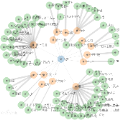Knowledge graph reasoning, which aims at predicting the missing facts through reasoning with the observed facts, is critical to many applications. Such a problem has been widely explored by traditional logic rule-based approaches and recent knowledge graph embedding methods. A principled logic rule-based approach is the Markov Logic Network (MLN), which is able to leverage domain knowledge with first-order logic and meanwhile handle their uncertainty. However, the inference of MLNs is usually very difficult due to the complicated graph structures. Different from MLNs, knowledge graph embedding methods (e.g. TransE, DistMult) learn effective entity and relation embeddings for reasoning, which are much more effective and efficient. However, they are unable to leverage domain knowledge. In this paper, we propose the probabilistic Logic Neural Network (pLogicNet), which combines the advantages of both methods. A pLogicNet defines the joint distribution of all possible triplets by using a Markov logic network with first-order logic, which can be efficiently optimized with the variational EM algorithm. In the E-step, a knowledge graph embedding model is used for inferring the missing triplets, while in the M-step, the weights of logic rules are updated based on both the observed and predicted triplets. Experiments on multiple knowledge graphs prove the effectiveness of pLogicNet over many competitive baselines.
翻译:知识图表推理的目的是通过观察到的事实推理预测缺失的事实,对许多应用至关重要。这样一个问题通过传统逻辑基于规则的方法和最近的知识图嵌入方法广泛探讨。一个基于原则逻辑的方法是Markov逻辑网络(MLN),它能够以一阶逻辑利用域知识,同时处理其不确定性。然而,由于图结构复杂,MLNs的推理通常非常困难。与MLNs不同的是,知识图嵌入方法(如TransE、DistMult)学习有效的实体和关系嵌入推理,而这种方法的效果和效率更高。然而,它们无法利用域知识。在本文件中,我们提议了概率逻辑神经网络(PogicNet),它将这两种方法的优势结合起来。一个PLogicNet 定义了所有可能的三重组合分布,它使用Markov逻辑网络与一阶的逻辑嵌入方法(如 Transyal EM combliction) 。在Estection中,在“Estepreport”中,一个知识的三重图是用来观测到的三重的逻辑图,而在“三重”中,在“三重”中,在“逻辑模型中,在“三重”中,在“逻辑”中,在“三重”中,在“逻辑”中,在“三重”中则中则中则中则被观测到用于。





